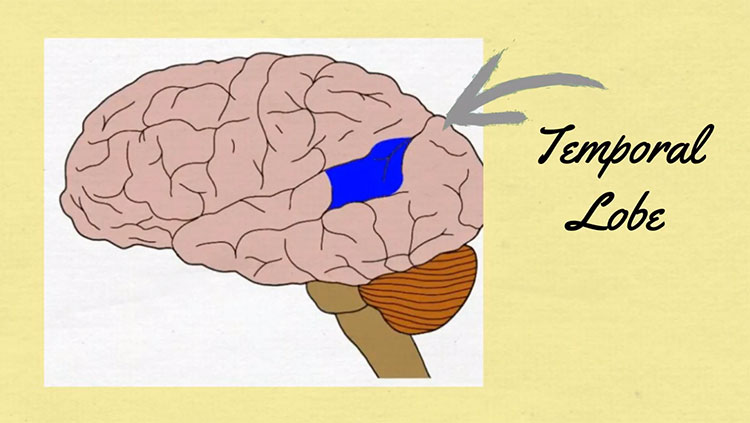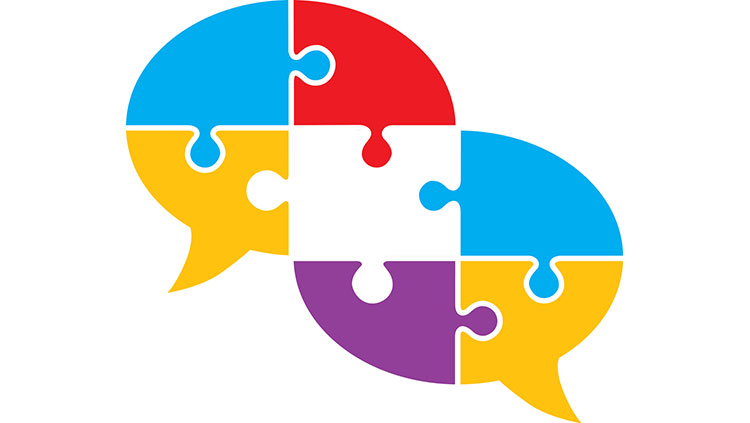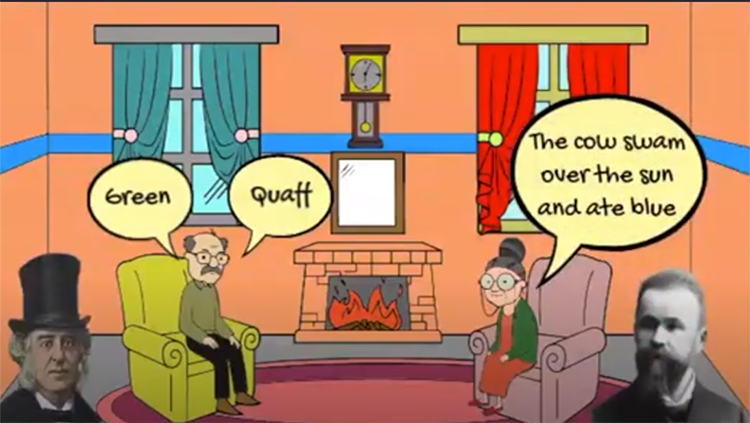The New Neuroscience of Stuttering
- Published30 Nov 2020
- Author Amber Dance
- Source Knowable Magazine

Gerald Maguire has stuttered since childhood, but you might not guess it from talking to him. For the past 25 years, Maguire — a psychiatrist at the University of California, Riverside — has been treating his disorder with antipsychotic medications not officially approved for the condition. Only with careful attention might you discern his occasional stumble on multisyllabic words like “statistically” and “pharmaceutical.”
Maguire has plenty of company: More than 70 million people worldwide, including about 3 million Americans, stutter — that is, they have difficulty with the starting and timing of speech, resulting in halting and repetition. That number includes approximately 5 percent of children, many of whom outgrow the condition, and 1 percent of adults. Their numbers include presidential candidate Joe Biden, deep-voiced actor James Earl Jones and actress Emily Blunt. Though those people and many others, including Maguire, have achieved career success, stuttering can contribute to social anxiety and draw ridicule or discrimination by others.
Maguire has been treating people who stutter, and researching potential treatments, for decades. He receives daily emails from people who want to try medications, join his trials, or even donate their brains to his university when they die. He’s now embarking on a clinical trial of a new medication, called ecopipam, that streamlined speech and improved quality of life in a small pilot study in 2019.
“We are in the middle of an absolute explosion of knowledge being developed about stuttering,” Yaruss says.
Others, meanwhile, are delving into the root causes of stuttering, which also may point to novel treatments. In past decades, therapists mistakenly attributed stuttering to defects of the tongue and voice box, to anxiety, trauma or even poor parenting — and some still do. Yet others have long suspected that neurological problems might underlie stuttering, says J. Scott Yaruss, a speech-language pathologist at Michigan State University in East Lansing. The first data to back up that hunch came in 1991, Yaruss says, when researchers reported altered blood flow in the brains of people who stuttered. Over the past two decades, continuing research has made it more apparent that stuttering is all in the brain.
“We are in the middle of an absolute explosion of knowledge being developed about stuttering,” Yaruss says.
There’s still a lot to figure out, though. Neuroscientists have observed subtle differences in the brains of people who stutter, but they can’t be certain if those differences are the cause or a result of the stutter. Geneticists are identifying variations in certain genes that predispose a person to stutter, but the genes themselves are puzzling: Only recently have their links to brain anatomy become apparent.
Maguire, meanwhile, is pursuing treatments based on dopamine, a chemical messenger in the brain that helps to regulate emotions and movement (precise muscle movements, of course, are needed for intelligible speech). Scientists are just beginning to braid these disparate threads together, even as they forge ahead with early testing for treatments based on their discoveries.
Slowed circuitry
Looking at a standard brain scan of someone who stutters, a radiologist won’t notice anything amiss. It’s only when experts look closely, with specialized technology that shows the brain’s in-depth structure and activity during speech, that subtle differences between groups who do and don’t stutter become apparent.
The problem isn’t confined to one part of the brain. Rather, it’s all about connections between different parts, says speech-language pathologist and neuroscientist Soo-Eun Chang of the University of Michigan in Ann Arbor. For example, in the brain’s left hemisphere, people who stutter often appear to have slightly weaker connections between the areas responsible for hearing and for the movements that generate speech. Chang has also observed structural differences in the corpus callosum, the big bundle of nerve fibers that links the left and right hemispheres of the brain.
These findings hint that stuttering might result from slight delays in communication between parts of the brain. Speech, Chang suggests, would be particularly susceptible to such delays because it must be coordinated at lightning speed.
Chang has been trying to understand why about 80 percent of kids who stutter grow up to have normal speech patterns, while the other 20 percent continue to stutter into adulthood. Stuttering typically begins when children first start stringing words together into simple sentences, around age 2. Chang studies children for up to four years, starting as early as possible, looking for changing patterns in brain scans.
It’s no easy feat to convince such young children to hold still in a giant, thumping, brain-imaging machine. The team has embellished the scanner with decorations that hide all the scary parts. (“It looks like an ocean adventure,” Chang says.) In kids who lose their stutter, Chang’s team has observed that the connections between areas involved in hearing and ones involved in speech movements get stronger over time. But that doesn’t happen in children who continue to stutter.
In another study, Chang’s group looked at how the different parts of the brain work simultaneously, or don’t, using blood flow as a proxy for activity. They found a link between stuttering and a brain circuit called the default mode network, which has roles in ruminating over one’s past or future activities, as well as daydreaming. In children who stutter, the default mode network seems to insert itself — like a third person butting in on a romantic date — into the conversation between networks responsible for focusing attention and creating movements. That could also slow speech production, she says.
These changes to brain development or structure might be rooted in a person’s genes, but an understanding of this part of the problem has also taken time to mature.
All in the family
In early 2001, geneticist Dennis Drayna received a surprising email: “I am from Cameroon, West Africa. My father was a chief. He had three wives and I have 21 full and half siblings. Almost all of us stutter,” Drayna recalls it saying. “Do you suppose there could be something genetic in my family?”
Drayna, who worked at the National Institute on Deafness and Other Communication Disorders, already had a longstanding interest in the inheritance of stuttering. His uncle and elder brother stuttered, and his twin sons did so as children. But he was reluctant to make a transatlantic journey based on an email, and wary that his clinical skills weren’t up to analyzing the family’s symptoms. He mentioned the email to current National Institutes of Health director Francis Collins (director of the National Human Genome Research Institute at that time), who encouraged him to check it out, so he booked a ticket to Africa. He has also traveled to Pakistan, where intermarriage of cousins can reveal gene variants linked to genetic disorders in their children.
Even with those families, finding the genes was slow going: Stuttering isn’t inherited in simple patterns like blood types or freckles are. But eventually, Drayna’s team identified mutations in four genes — GNPTAB, GNPTG and NAGPA from the Pakistan studies, and AP4E1 from the clan in Cameroon — that he estimates may underlie as many as one in five cases of stuttering.
Oddly, none of the genes that Drayna identified have an obvious connection to speech. Rather, they all are involved in sending cellular materials to the waste-recycling compartment called the lysosome. It took more work before Drayna’s team linked the genes to brain activity.
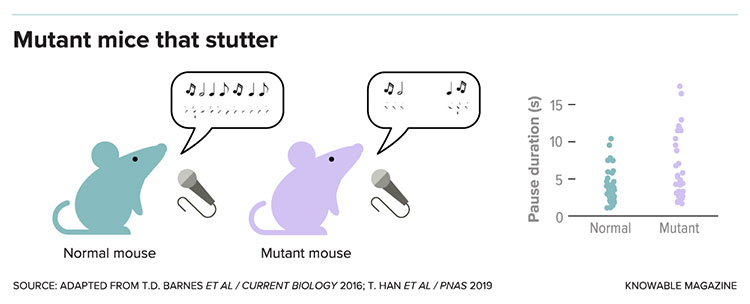
They started by engineering mice to have one of the mutations they’d observed in people, in the mouse version of GNPTAB, to see if it affected the mice’s vocalizations . Mice can be quite chatty, but much of their conversation takes place in an ultrasonic range that people can’t hear. Recording the ultrasonic calls of pups, the team observed patterns similar to human stuttering. “They have all these gaps and pauses in their train of vocalizations,” says Drayna, who cowrote an overview of genetics research on speech and language disorders for the Annual Review of Genomics and Human Genetics.
Still, the team struggled to spot any clear defect in the animals’ brains — until one determined researcher found that there were fewer of the cells called astrocytes in the corpus callosum. Astrocytes do big jobs that are essential for nerve activity: providing the nerves with fuel, for example, and collecting wastes. Perhaps, Drayna muses, the limited astrocyte population slows down communication between the brain hemispheres by a tiny bit, only noticeable in speech.
Drayna’s research has received mixed reviews. “It’s really been the pioneering work in the field,” says Angela Morgan, a speech-language pathologist at the University of Melbourne and Murdoch Children’s Research Institute in Australia. On the other hand, Maguire has long doubted that mutations in such important genes, used in nearly all cells, could cause defects only in the corpus callosum, and only in speech. He also finds it difficult to compare mouse squeaks to human speech. “That’s a bit of a stretch,” he says.
Scientists are sure there are more stuttering genes to find. Drayna has retired, but Morgan and collaborators are initiating a large-scale study in the hopes of identifying additional genetic contributors in more than 10,000 people.
The dopamine connection
Maguire has been tackling stuttering from a very different angle: investigating the role of dopamine, a key signaling molecule in the brain. Dopamine can ramp up or down the activity of neurons, depending on the brain location and the nerve receptors it sticks to. There are five different dopamine receptors (named D1, D2, and so on) that pick up the signal and respond.
During the 1990s, Maguire and colleagues were among the first to use a certain kind of brain scan, positron emission tomography, on people who stutter. They found too much dopamine activity in these people’s brains. That extra dopamine seems to stifle the activity of some of the brain regions that Chang and others have linked to stuttering.
Backing up the dopamine connection, other researchers reported in 2009 that people with a certain version of the D2 receptor gene, one that indirectly enhances dopamine activity, are more likely to stutter.
So Maguire wondered: Could blocking dopamine be the answer? Conveniently, antipsychotic drugs do just that. Over the years, Maguire has conducted small, successful clinical studies with these medications including risperidone, olanzapine and lurasidone. (Personally, he prefers the last because it doesn’t cause as much weight gain as the others.) The result: “Your stuttering won’t completely go away, but we can treat it,” he says.
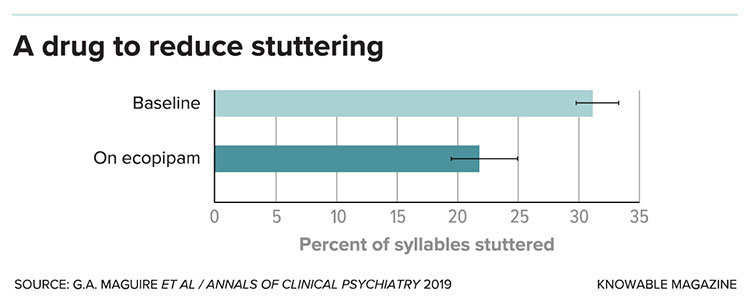
None of those medications are approved for stuttering by the US Food and Drug Administration, and they can cause unpleasant side effects, not just weight gain but also muscle stiffness and impaired movement. In part, that’s because they act on the D2 version of the dopamine receptor. Maguire’s new medication, ecopipam, works on the D1 version, which he expects will diminish some side effects — though he’ll have to watch for others, such as weight loss and depression.
In a small study of 10 volunteers, Maguire, Yaruss and colleagues found that people who took ecopipam stuttered less than they did pre-treatment. Quality-of-life scores, related to feelings such as helplessness or acceptance of their stutter, also improved for some participants.
Ecopipam isn’t the only treatment under consideration. Back in Michigan, Chang hopes that stimulation of specific parts of the brain during speech could improve fluency. The team uses electrodes on the scalp to gently stimulate a segment of the hearing area, aiming to strengthen connections between that spot and the one that manages speech movements. (This causes a brief tickle sensation before fading, Chang says.) The researchers stimulate the brain while the person undergoes traditional speech therapy, hoping to enhance the therapy’s effects. Because of the Covid-19 pandemic, the team had to stop the study with 24 subjects out of a planned 50. They’re analyzing the data now.
Connecting the dots
Dopamine, cellular waste disposal, neural connectivity — how do they fit together? Chang notes that one of the brain’s circuits involved in stuttering includes two areas that make and use dopamine, which might help explain why dopamine is important in the disorder.
She hopes that neuroimaging can unite the different ideas. As a first stab, she and collaborators compared the problem areas identified by her brain scans to maps of where various genes are active in the brain. Two of Drayna’s genes, GNPTG and NAGPA, were active at high levels in the speech and hearing network in the brains of non-stutterers, she saw. That suggests those genes are really needed in those areas, bolstering Drayna’s hypothesis that defects in the genes would interfere with speech.
The team also observed something novel: Genes involved in energy processing were active in the speech and hearing areas. There’s a big rise in brain activity during the preschool years, when stuttering tends to start, Chang says. Perhaps, she theorizes, those speech-processing regions don’t get all the energy they need at a time when they really need to be cranking at maximum power. With that in mind, she plans to look for mutations in those energy-control genes in children who stutter. “There are obviously a lot of dots that need to be connected,” she says.
Maguire is also connecting dots: He says he’s working on a theory to unite his work with Drayna’s genetic findings. Meanwhile, after struggling through med school interviews and choosing a career in talk therapy despite his difficulties with speech, he’s hopeful about ecopipam: With colleagues, he’s starting a new study that will compare 34 people on ecopipam with 34 on placebo. If that treatment ever becomes part of the standard stuttering tool kit, he will have realized a lifelong dream.
CONTENT PROVIDED BY
Knowable Magazine is an independent journalistic endeavor from Annual Reviews.




